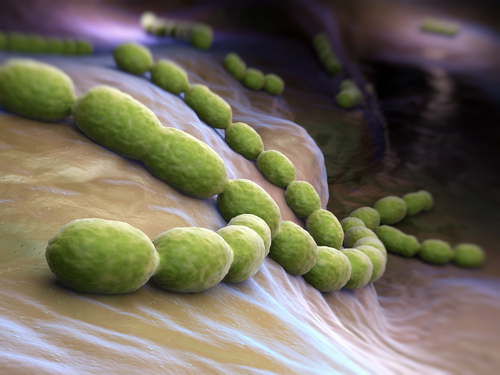Inflammatory bowel disease (IBD) refers to a range of conditions resulting from chronic or recurring immune response causing inflammation of the gastrointestinal tract. The two most common inflammatory bowel diseases are ulcerative colitis and Crohn’s disease. Each disorder is distinct in its presentation and course, and both are chronically relapsing illnesses. Inflammation affects the entire digestive tract in Crohn’s disease and only the large intestine in ulcerative colitis, but both illnesses are characterized by an abnormal response to the body’s immune system.
In people with IBD, the immune system mistakes food, bacteria, and other materials in the intestine for foreign substances, which incites it to attack the cells of the intestinal walls. In the process, the body sends white blood cells into the lining of the intestines where they produce chronic inflammation. IBD is a condition that gets worse over time and causes severe gastrointestinal symptoms that can affect quality of life.
Despite histological differences between ulcerative colitis and Crohn’s disease, dietary therapy (with the exception of known efficacy of enteral therapy and CD) has often been similar for both, involving options that include increased fluids, avoidance of fatty foods, dietary fiber, and dairy products if lactose intolerant. Presently, an alteration of the intestinal microbiome is believed to be a major factor in the pathogenesis of IBD, and this change provides a possible pathway for dietary manipulations of the microbiome that may reduce inflammation in these condition.Microbiome refers to the microorganisms — and their genes — that inhabit a particular environment. These microorganisms that live and on us are called the human microbiome. Our gut contains trillions of “good bacteria” that have profound influences on immune development, health, and disease.
The Center for Disease Control (CDC) cautions that inflammatory bowel diseases such as ulcerative colitis and Crohn’s disease should not be confused with irritable bowel syndrome (IBS), a less-serious but still potentially disruptive disorder that affects the colon’s muscle contractions.
 Barbara Olendzki, RD, MPH, LDN, director of the University of Massachusetts Medical School Center for Applied Nutrition, and colleagues have developed the IBD-AID: Anti-inflammatory Diet for Inflammatory Bowel Disease, a set of anti-inflammatory diet recommendations as a fundamental element of inflammatory bowel disease management and treatment.
Barbara Olendzki, RD, MPH, LDN, director of the University of Massachusetts Medical School Center for Applied Nutrition, and colleagues have developed the IBD-AID: Anti-inflammatory Diet for Inflammatory Bowel Disease, a set of anti-inflammatory diet recommendations as a fundamental element of inflammatory bowel disease management and treatment.
Ms. Olendzki is also an assistant professor of medicine in the Division of Preventive and Behavioral Medicine, and she works with all Preventive and Behavioral research studies that involve dietary interventions, assists with coordination and teaching nutrition to medical students, and sees outpatients for nutrition counseling, specializing in cardiac concerns, cancer, gastrointestinal problems, diabetes, obesity, and inflammatory diseases. She has over 15 years of experience in the nutrition field, and her research interests include investigating the effect of diet and other lifestyle factors on obesity, diabetes, and heart disease, the IBD-AID: Anti-inflammatory Diet for Inflammatory Bowel Disease, and improving methods of dietary assessment in epidemiological studies.
The Anti-Inflammatory Diet for IBD (IBD-AID) is a nutritional regime that restricts intake of some carbohydrates such as refined sugar, gluten-based grains and certain starches from the diet. These carbohydrates are thought to provide an intestinal substrate welcoming to pro-inflammatory bacteria.
A quickview overview of the highlights of the IBD-AID can be found here:
http://www.umassmed.edu/nutrition/ibd/ibd-aid-diet-quick-view/
An IBD-AID Q&A Reference is here:
http://www.umassmed.edu/nutrition/ibd/ibd-aid-reference/
An exhaustive list of IBD-AID recipes can be accessed here:
http://www.umassmed.edu/nutrition/ibd/ibd-aid/
“Our aim is to provide a dietary therapy approach that addresses nutrient adequacy, malabsorption issues and symptom relief, and facilitates remission,” says Prof. Olendzki in a UMass Medical School release. “We hope to show through further research that this may alter the course of the disease.”
Last year, results of a small, retrospective case study of the IBD Anti-inflammatory Diet (IBD-AID) was published in Nutrition Journal. All patients who adhered to the diet for at least four weeks experienced significant reduction in their symptoms, and all were all able to discontinue at least one of their IBD medications.
The study, entitled “An anti-inflammatory diet as treatment for inflammatory bowel disease: a case series report“ (Nutrition Journal 2014, 13:5 doi:10.1186/1475-2891-13-5 ) is coauthored by Professor Olendzki, Gioia M Persuitte, and Yunsheng Ma of the Division of Preventive and Behavioral Medicine, University of Massachusetts Medical School in Worcester; Taryn D Silverstein and David Cave of the school’s Department of Gastroenterology and Katherine R Baldwin of the UMass Memorial Medical Center,Department of Medicine and Pediatrics,
An electronic version of the complete Open Access article can be found online at: http://www.nutritionj.com/content/13/1/5
The coauthors note that goals for treatment of IBD are induction of remission, maintenance of remission, reduction in the need for long-term use of corticosteroids, improved quality of life, and improved prognosis. They observe that mainstays of current treatment are comprised of anti-inflammatory agents including corticosteroids, immunomodulators, and biologic agents. There are also surgical options including colectomy, which while curative for patients with UC, can result in a pouch or end ileostomy in approximately 30 percent of patients. Neither of these surgical options are without complications and up to 70 percent of patients with a pouch may develop pouchitis. An even higher percentage of CD patients need surgery, with upward of 80 percent of patients requiring surgical resection that is not necessarily curative.
They observe that until recently, investigation of nutritional approaches in treating IBD have been largely limited to use of enteral and total parenteral nutrition with the aim of providing bowel res. They maintain that dietary whole food recommendations for CD and UC are poorly developed, even though patients often ask for dietary advice. However, no consensus regarding specific diet currently exists for patients with IBD. Physicians are not provided with specific dietary treatments to offer their IBD patients, and recommendations for normal diet are often based upon a philosophy of ‘if it hurts, don’t do it.’ Most dietary guidelines, although varied in scope and complexity, indicate that limiting lactose, excess fat, excess carbohydrates, and reducing fiber in the diet is necessary, particularly during disease flares. Mineral and vitamin supplementation may or may not assist with nutrient deficiencies and malabsorption. In addition, many patients also experience other food intolerances.
Consequently, in order to provide a dietary therapy approach that would address nutrient adequacy, malabsorption issues, and symptoms, the research team developed the IBD-Anti-Inflammatory Diet, or IBD-AID, which was then was offered to patients who were refractory to pharmacological therapy, or treatment was not as effective as desired. The study described in the NNutritionJournal paper is a retrospective case series to demonstrate beneficial effects of the IBD-AID on a small number of patients.
The coauthors describe their Anti-Inflammatory Diet (IBD-AID) as a nutritional regimen for inflammatory bowel disease (IBD) that restricts intake of certain carbohydrates, includes the ingestion of pre- and probiotic foods, and modifies dietary fatty acids to demonstrate the potential of an adjunct dietary therapy for IBD treatment.
For the study, 40 patients with IBD were consecutively offered the IBD-AID to help treat their disease, and then retrospectively reviewed. Medical records of 11 of those patients underwent further review to determine changes in the Harvey Bradshaw Index (HBI) or Modified Truelove and Witts Severity Index (MTLWSI) , before and after the diet.
Of the 40 patients with IBD approached, 13 chose not to attempt the diet (33 percent). Twenty-four patients had either a good or very good response after reaching compliance (60 percent), and three patients’ results were mixed (seven percent). Of the 11 adult patients who underwent further medical record review, eight with CD, and three with UC, the age range was 19 to 70 years, and they followed the diet for four or more weeks. After following the IBD-AID, all (100 percent) patients were able to discontinue at least one of their prior IBD medications, and all patients had symptom reduction including bowel frequency. The mean baseline HBI was 11 (range 120), and the mean follow-up score was 1.5 (range 03). The mean baseline MTLWSI was 7 (range 6-8), and the mean follow-up score was 0. The average decrease in the HBI was 9.5 and the average decrease in the MTLWSI was 7.
“We hypothesize that specific dietary modifications may significantly alter the intestinal microbiome and improve nutrient absorption, which in turn alters the immune response in such a way as to reduce disease activity and improve outcomes,” Prof. Olendzki explains. “Unlike SCD (the more restrictive Specific Carbohydrate Diet), AID includes all three macronutrientsprotein and fats as well as carbohydratesto provide more nutrients that may protect against inflammation.”
The coauthors observe that there has been an increase in publications over the past ten years with regard to food-based strategies used to alter the intestinal microflora as an alternative or adjunctive therapy for the treatment of IBD, that the altered bacteria in the microbiome of IBD patients is said to drive inflammatory responses, and there are a growing number of articles linking particular foods that influence the intestinal microbiome, by withholding certain foods that are not well tolerated by patients, or introducing others that can improve symptoms.
The dietary pattern of the IBD-AID is therefore carefully oriented to decrease inflammation and improve nutritional status, and thought to maintain a beneficial intestinal bacterial balance. However, this theory has yet to be proven by rigorous scientific examination. They also acknowledge that IBD-AID can be difficult and restrictive diet; with adherence largely dictated by personal motivation, support from family and friends, and skills in the kitchen and the marketplace. “Whether they want to or not, [patients must] modify their diets so they are not injured on the inside,” declares Prof. Olendzki. Consultation and continued support from a knowledgeable dietitian may enhance compliance with the diet.
The researchers conclude that his case series is promising, and serves to highlight the importance of dietary manipulation as an adjunct to the limited existing management options for IBD, as well as indicating potential for the IBD-AID as an adjunct dietary therapy for the treatment of IBD, but it must be followed with rigorous research and standardized study design to detect molecular markers of inflammatory and histo-pathological changes to correlate with clinical outcomes, and that a randomized clinical trial is warranted.
Based on the success of this pilot study, Prof. Olendzki has applied for funding for a larger study to further test the effectiveness of the diet, and plans to conduct further research to determine the actual composition of the bacterial microbiota that is promoted by the anti-inflammatory diet in order to assess correlations with symptoms and disease progression. “We are eager to further test the hypothesis that the IBD-AID promotes favorable changes in the microbiota that translate to improved symptomatology and overall quality of life observed in our preliminary studies,” she explains. “We want to bring more attention to this disease and change the treatment paradigm to one where patients can do something for themselves.”
Sources:
University of Massachusetts Medical School
Nutrition Journal
The Centers for Disease Control (CDC)
Image Credit:
University of Massachusetts Medical School

